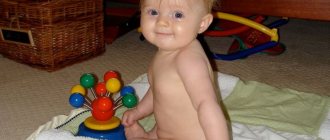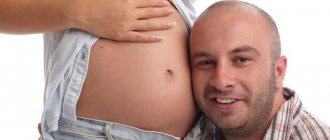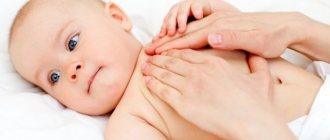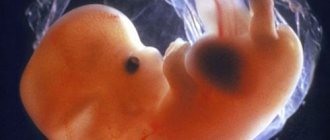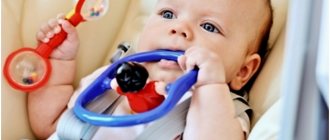Not everyone knows how a child feeds before birth while in the womb. Some are convinced that the baby gets everything it needs from the placenta or from amniotic fluid, which is not associated with the pregnant woman’s body. Therefore, the mother’s diet and her bad habits do not in any way affect the health of the fetus. Reasoning in this way, careless women justify their reluctance to give up smoking and drinking alcohol during pregnancy. However, the health and development of the fetus depends entirely on the behavior of the mother. Until childbirth, a pregnant woman and her child are a single whole.
The earliest stage of development
After the fusion of the egg and sperm, a zygote is formed. It is a totipotent cell containing a complete double set of chromosomes inherited from the father and mother. Totipotent cells are those from which any organ or whole organism can develop. After about a day, the first fragmentation of the zygote occurs, as a result of which it is divided into 2 genetically equivalent cells (blastomeres). The first division takes about 30 hours. The stage of two blastomeres is followed by the stage of three blastomeres. After 40 hours, the future embryo already consists of 4 cells covered with one common membrane. After the third stage of division, on the 4th day after fertilization, the process accelerates.
When the zygote is crushed, light and dark blastomeres are formed. Superficial light cells will later turn into trophoblast. The extraembryonic membrane (chorion) will form from the trophoblast. It will fuse with the tissues of the uterus, forming the placenta. Dark internal blastomeres at the 2nd week of pregnancy are transformed into the body of the embryo and extra-embryonic organs - the amnion, yolk sac and allantois. The amnion will later develop into the inner lining of the fetal sac, filled with amniotic fluid.
The yolk sac (umbilical vesicle) performs the same role as the yolk in a chicken egg. It is a source of nutrients for the embryo. Blood islands appear in it, from which the first blood cells and blood vessels will form. Blood flows from the embryo to the walls of the yolk sac through the primitive aorta. It circulates through a wide network of capillaries and returns through the vitelline vein to the tubular heart of the embryo. Together with the blood, nutrients from the yolk are transferred to the embryo, which it begins to feed on.
The yolk sac will not feed the fetus for long - about a week. It performs the hematopoietic function longer - up to 7-8 weeks of embryo development. Later it undergoes reverse development.
The allantois is a derivative of the yolk sac. It plays a big role in providing the fetus with nutrients and oxygen. With its help, the blood vessels of the embryo are connected to the chorion.
The constantly dividing zygote turns into a dense cluster of cells (morula). After a cavity (blastula) appears between the cells, the morula turns into a blastocyst (a vesicle with liquid).
The first days after fertilization: feeding from your own reserves
In the first days after the fusion of gametes, the nutrition of the embryo, which is at the blastocyst stage, occurs due to microelements accumulated in the egg. This is enough for the period of time until the blastocyst moves through the fallopian tubes, enters the uterine cavity and attaches to the endometrium.
After implantation, the yolk sac is formed from the endoblastic vesicle of the embryo. This is a provisional organ that temporarily performs the role of organs that have not yet been formed. In addition to the hematopoietic and synthetic functions, it also performs an metabolic function, supplying nutrients to the embryo.
After implantation of the fertilized egg
The blastocyst penetrates the uterine cavity on the 5th day. For about 2 more days, the fertilized egg is in a free state, looking for a suitable place to implant into the inner lining of the uterus (endometrium). All this time, the source of nutrition for the embryo is the yolk sac. If the blastocyst hesitates and remains free for too long, the fetus may not have enough nutrients from the yolk sac. Without nutrition, the embryo dies.
On days 6-7 after fertilization, the implantation process begins. First, the blastocyst adheres to the endometrium (adhesion), then the process of penetration (invasion) begins. The success of invasion depends on the activity of the blastocyst. Her blastula secretes enzymes that help dissolve the top layer of the endometrium. If enough enzymes are produced, the blastocyst is safely immersed in the thickness of the endometrium. The wound on the surface of the endometrium heals immediately.
READ ALSO: At what stage does the embryo’s heart begin to beat and how to hear it?
After the fertilized egg penetrates the endometrial layer, the trophoblast is activated. From the chorion formed from it, villi grow - tentacles. They penetrate into the deeper layers of the endometrium, rupturing the blood vessels of the uterus. Gaps appear between the villi and uterine tissues. They fill with blood that pours out from damaged blood vessels. Blood washes the fetus, supplying it with nutrients and oxygen from the mother's body.
The barrier between the blood of the pregnant woman and the fetus consists only of the tissues of the chorionic villi and the walls of the capillaries of the umbilical vessels. This ensures the maximum possible absorption of nutrients and oxygen.
During this period of development, the embryo is most vulnerable. All toxins contained in the maternal blood freely penetrate into the fetus’s body. If a woman drinks alcohol, smokes or takes medications, the embryo may die from poisoning. His own defense system had not yet developed.
Immediately after implantation, three germ layers of the fetus are formed, from which all its tissues and organs are later formed. If at this stage of pregnancy the blood of the expectant mother contains a lot of toxins, the formation of the germ layers of the fetus may fail. The consequences of violations are pathologies of various vital organs.
How food is supplied to a baby in the womb - what not to do
Nutrients reach the baby through the placenta. The child receives practically the same thing as you, both food and drink. It is not recommended to drink alcohol, as well as too fatty or spicy foods, all this will negatively affect the development of the fetus, especially alcoholic drinks. They directly enter the blood through the placenta; subsequently, alcohol can negatively affect the state of the cardiovascular, nervous and respiratory systems, and also slow down brain function.
Separately, it is worth saying a few words about smoking. Although the placenta protects the child from the negative consequences of this habit, the development of the lungs, in the second half of pregnancy, let’s just say, can slow down, and hypoxia also develops - a lack of oxygen, which can trigger asthma after birth.
Formation of the placenta
At 3 weeks after fertilization, the placentation period begins. The placenta is the organ that connects the pregnant woman and the baby. Through it, the exchange of substances takes place between the maternal body and the fetus. The embryo receives nutrients and oxygen by releasing waste products and carbon dioxide. The placenta also performs a barrier function, regulating the supply of nutrients to the fetus, as well as retaining viruses and toxins that are dangerous to it. The process of placenta formation occurs most intensively until the 6th week of pregnancy.
The formation of the placenta begins with the ingrowth of blood vessels into the chorionic villi. One stem villi and its numerous branches containing embryonic blood vessels form the fetal lobule of the placenta (cotyledon). The embryonic part of the placenta contains many cup-shaped cotyledons separated by connecting partitions (septa).
On the side of the uterus, caruncles are formed, which are located opposite the cotyledons. The maternal spiral arteries supply nutrients and oxygen to the intervillous space. They are absorbed into the blood vessels of embryonic cotyledons. When transferring nutrients, the blood of the mother and fetus does not mix.
As the baby grows, the number of cotyledons and blood vessels increases rapidly. By the 140th day of pregnancy, the placenta contains 10-12 large, 40-50 small and 150-200 rudimentary cotyledons. The thickness of the child's seat reaches 1.5-2 cm.
Subsequently, the mass of the placenta increases due to the development of existing cotyledons. The formation of blood vessels is completed by the 20th week of pregnancy. At this moment, the pregnant woman’s blood pressure decreases, since there is practically no resistance to blood flow from the maternal arteries.
The mother transfers nutrients to the fetus through hundreds of blood vessels. The constancy of blood flow is maintained through a multi-stage system of regulatory mechanisms. On the maternal side, blood flow is determined by the movement of maternal blood and contractions of the uterus. On the fetal side, blood circulation is ensured by the heartbeat and the muscles of the villi. The development of the child depends entirely on the uteroplacental and fetal placental circulation.
How does the fetus feed in the womb at all stages of development?
› Pregnancy
As soon as the egg meets the sperm, an intensive process of its modification begins. First, a zygote is formed, then a blastocyst; at the end of the embryonic stage, the fetal (fetal) period begins.
The baby changes every day, and these metamorphoses require a huge amount of energy and nutrients. We will tell you in this material how and what the baby eats in the mother’s womb at different stages of its development.
Nutritional features of the baby
Feeding methods depend on the baby's stage of development. At any stage, the child needs oxygen, essential minerals, vitamins, glucose, and hormones. These substances ensure metabolic processes, growth and division of cells in tissues and organs, growth of bone and muscle tissue. But the baby receives these substances in different ways at different stages of pregnancy.
In the second and third trimester
At 12-14 weeks of pregnancy, the young placenta begins to function instead of the chorion. It provides the baby with nutrition, protects it, produces a number of hormones important for the continuation of pregnancy, and also acts as a “vacuum cleaner”, removing the baby’s waste products back into the mother’s body.
This process is quite complicated. The vein is responsible for supplying the baby with maternal blood, saturated with oxygen, vitamins and minerals. Two arteries carry urea, carbon dioxide, creatine and creatinine from the baby through the placenta. Metabolic products are utilized by the mother's kidneys and liver.
In our usual understanding, the child does not eat at this stage; he receives everything he needs immediately into the blood.
But the fetus perfectly “trains” the digestive system - it swallows amniotic fluid along with the nutrients it contains, as well as exfoliated epithelial cells and lanugo hairs.
These “impurities” are not digested and are deposited in the intestines of the fetus in the form of dark green feces, which is called “meconium”.
From the moment the swallowing reflex develops, the baby begins to write, his urine enters the amniotic fluid back and participates in the process of their renewal. The water composition is cleaned every 3.5 hours.
What from the mother's diet gets to the child?
The embryo in the early stages of pregnancy does not distinguish tastes and does not have any gastronomic preferences. However, from the second trimester, the baby begins to “understand” what his mother eats.
“Echoes” of tastes are present in the amniotic fluid, which the baby so diligently swallows. As taste buds develop, the baby begins to distinguish sweet from bitter, sour from salty. Naturally, already at this age children prefer sweets.
That is why after the mother eats a piece of chocolate, the fetal movements become more active.
If a woman eats too much sweets, the burden of breaking down glucose will fall not only on her own pancreas, but also on the pancreas of her child - it will also be difficult for him to cope with the abundance of sugar. Not only the weight of the pregnant woman herself, but also the lipid metabolism of her baby depends on the abundance of fatty foods.
The placenta, which is a reliable barrier, absorbs salts and some toxic substances as much as possible, preventing them from reaching the child.
But its possibilities are not limitless; if a woman has a poor diet and excessive use of drugs and alcohol, her “children’s place” will quickly age and lose some of its functions, which can lead to the child receiving substances from the mother’s body that are not the most beneficial for him.
A woman's diet should be balanced, rich in vitamins, slow carbohydrates, proteins, fats and fructose. Potassium, calcium, magnesium, and iron must be present.
If something is missing in a woman’s diet, it will affect the child, but not immediately.
Nature has arranged it so that for quite a long time the baby can “compensate” for the substances it lacks, taking them from the mother’s body.
So, if the amount of calcium consumed by the mother in food is insufficient, the child will “take away” this substance from the parent , as a result her teeth, hair, nails will become fragile, brittle, and her legs will cramp at night, caused by a violation of phosphorus and calcium metabolism.
If there is a lack of iron, the expectant mother may develop anemia; as a result, the baby will not receive enough oxygen in the blood and will begin to suffer from hypoxia - a condition that poses a great danger to its development and even life.
The statement that a pregnant woman should eat for two is wrong, from a medical point of view, it is even dangerous.
The child receives from the mother's blood as much as he needs; he simply is not able to absorb more of the same vitamin C or vitamin E.
But large amounts of food contribute to pathological weight gain in the pregnant woman and the baby, which is fraught with problems during childbirth, late toxicosis (preeclampsia) with all the ensuing consequences.
What happens during toxicosis?
What happens to the baby if the mother has toxicosis and cannot eat at all worries every pregnant woman who finds herself in such an unpleasant situation. Toxicosis with eating disorders usually occurs in early pregnancy.
At this time, the baby is “fed” by the yolk sac, and the lack of normal and nutritious nutrition on the part of the parent can do little harm to the child.
A little later, the baby, as in the case of a deficiency of certain substances, will get what it needs from the mother’s body.
Moderate toxicosis, in which vomiting does not occur every hour, does not pose a particular danger to the mother and fetus.
But severe, frequent vomiting, the inability to eat and drink, swelling or very rapid weight loss are alarming symptoms for which a woman is often advised to undergo hospital treatment.
In a hospital setting, she will be given the necessary vitamins and minerals intravenously or by drip so that the baby does not need them.
To the best of her ability, a woman should strive to eat healthy and vitamin-rich foods in small portions, even with toxicosis. Toxicosis is the very case in which quality is better than quantity.
Multivitamin complexes designed specifically for expectant mothers will help provide your baby with the necessary substances for development and growth. They contain the necessary substances in quantities that satisfy the daily needs of the female body, taking into account the needs of the growing child.
For information about nutrition during pregnancy, as well as what the health of the unborn child depends on, watch the following video.
medical reviewer, psychosomatics specialist, mother of 4 children
How does a baby feed in the mother's belly?
How do the necessary substances enter the body of the unborn child in the first and second trimester? Does the mother's diet affect the baby?
What does the fetus receive from the mother's body?
How a baby eats in the womb depends on the diet of the pregnant woman. Many nutrients are necessary for the successful development of the fetus, but some are especially important.
READ ALSO: What to do if a child often hiccups in the stomach during pregnancy?
Vitamin A is needed for metabolism. With its help, the child develops mucous membranes, retina and bone tissue.
Regularly receiving vitamin B1 from the mother, the baby grows actively. The vitamin improves metabolism in brain tissue, allowing it to actively develop.
Vitamin B2 is necessary for the creation of fetal tissue. It plays an important role in the formation of the visual organs. Visual acuity and light perception depend on riboflavin. By receiving the right amount of vitamin B2, the baby gains weight well, forms a healthy nervous system, mucous membranes and skin.
Riboflavin is needed for the absorption of iron and hemoglobin synthesis. The baby will use up the hemoglobin accumulated during intrauterine development until the age of six months.
Vitamin B5 is required for the child to carry out metabolism and produce hormones.
The supply of tissues with glucose and the release of carbohydrates accumulated in organs into the blood depend on vitamin B6. Pyridoxine is involved in hematopoiesis.
Vitamin B7 is needed to support the process of fetal cell division.
Thanks to the intake of vitamin B9, the baby’s immune system develops and functions. Folic acid prevents the occurrence of fetal neural tube pathologies and other developmental defects.
The synthesis of amino acids and proteins depends on the amount of vitamin B12 in maternal blood. It is involved in hematopoiesis. Cyanocobalamin accumulates in the liver during fetal development. Vitamin reserves last a child for a year.
By receiving vitamin PP, children can form the digestive system and regulate the functions of the thyroid gland and adrenal glands.
A child needs calcium to build bone and cartilage tissue. Phosphorus improves muscle condition and is involved in the transfer of hereditary qualities from parents to fetus.
If a pregnant woman receives few vitamins and microelements from food, the necessary substances are washed out of her body to ensure the growing fetus.
Fetal nutrition in the womb - when and how does it happen?
Pregnancy is a unique period in a woman’s life, and not only from an emotional and psychological point of view. For many months, everything she does can somehow affect the child growing in the womb.
This applies to physical activity, her state of mind, diseases and their treatment, and, of course, what she eats.
Any woman should, even before pregnancy, have information about how the baby feeds in the womb at different stages.
Intrauterine nutrition of the child in the first weeks
When does the embryo begin to feed from the mother?
Fetal nutrition in the second half of pregnancy
Maternal nutrition - fetal nutrition
Intrauterine nutrition of the child in the first weeks
It’s good when a girl prepares for motherhood in advance and excludes alcohol, fast food and other harmful foods from her diet, because two to three weeks after fertilization the embryo receives nutrition from the yolk sac, which is part of its membrane. Moving along the fallopian tube to the uterus, the embryo still exists as if separately, so if the nutritional reserves in the yolk sac are insufficient or they are destructive, it may die.
When does the embryo begin to feed from the mother?
Around the 16th day, the embryo reaches the uterus and attaches to its wall. By that time, the reserves in the yolk sac are running out, and the embryo begins to receive nutrition through the chorionic villi, which are about to become the placenta. From now on until the birth of the child, it is both a conductor and a filter for various substances entering the mother’s blood from the outside.
That is, already from the third week of pregnancy, the embryo begins to feed from the mother!
Structure and functions of the placenta
The placenta is multi-layered and consists of lobules filled with vessels. Some of them connect the uterus to the placenta, and the other part, uniting, turns into the umbilical cord, which connects the embryo to the placenta.
How a child is fed through the umbilical cord determines his height, weight, and health. If there is not enough something in the mother’s menu for the development of the baby, these substances will come from the woman’s body, depriving her of what she needs.
Along with the barrier, endocrine and respiratory functions, the placenta performs a nutritional function, supplying new life with the necessary substances:
- Proteins and lipids are building materials for living tissues;
- Glucose - it plays a major role in the nutrition of the fetus;
- Fats – for optimal metabolism;
- Vitamins. They accumulate in the placenta and reach the fetus in optimal combinations with other elements;
- Electrolytes and minerals – sodium, potassium, chlorides, calcium, phosphorus, iron;
- Water.
If the mother is physically exhausted, the child’s development may be delayed and the placenta may be disrupted.
Fetal nutrition in the second half of pregnancy
In the last months, the baby in the womb is still fed through the placenta, but the baby already looks like a newborn, the digestive organs are formed, and now the baby is able to swallow amniotic fluid, receiving from it all the required components, including enzymes for their digestion . This is how the preparation begins for the digestion of milk. Depending on what the mother ate, the amniotic fluid may change taste, and the fetus reacts to this with movements.
The placenta can't cope
Ideally, the placenta begins to age and thin when the baby is ready to be born, but sometimes this happens earlier, leading to premature birth or hospitalization for the mother. This process does not always depend on her lifestyle, but knowing how the child eats before birth, she and her environment are obliged to ensure his full development.
Maternal nutrition - fetal nutrition
So we found out that the nutrition of the fetus in the womb directly depends on what the woman eats.
Obviously, for the sake of the health and full development of the child, it is worth parting with some old eating habits for a while.
Is it healthy to eat sweets?
The sweet weakness of a woman during pregnancy must be pacified in every possible way.
A large amount of sweets puts a lot of stress on the pancreas of both the woman herself and her fetus.
A moderate amount of sugar in the daily diet will protect the expectant mother from empty calories. Fresh fruits will be an excellent alternative to store-bought pastries, cakes and similar confectionery delights, which, in addition to sugar, also contain absolutely unnecessary fat.
As you know, a woman’s body during pregnancy is especially sensitive to all kinds of diseases and infections. Therefore, it would be a good idea to exclude factors that increase the risk of caries.
Dairy
Nutrition during pregnancy should provide the body with calcium. Dairy products will be an ideal source. In any case, the embryo will receive the calcium necessary for its bones, if not with food, then from the internal reserves of the mother’s body, due to the health of her teeth and bones.
Of course, all mothers should take care of their children and make sure that they do not need anything, but not to their own detriment.
Calcium-rich dairy products will help maintain the health of the mother and ensure the full growth and development of the baby’s bones.
Salty foods and salt
Sodium, like other microelements, is necessary for a pregnant woman and her mother. But! Even for an ordinary person, excessive consumption of salt and excessively salty foods provokes edema and kidney problems. This happens due to fluid retention in the body. Pregnant women are strongly advised to minimize the amount of added salt to their food.
Vegetables and fruits
In the nutrition of the baby in the womb, that is, in the pregnant woman’s menu, it is necessary to include various colorful vegetables and fruits. This will provide the mother and her child with vital nutrients and satisfy the body’s need for vitamins, minerals, and antioxidants. All fruits and plants must be thoroughly washed before eating.
In late pregnancy, the embryo inside the womb can already recognize the taste of food by swallowing amniotic fluid. This means that in the future the baby, remembering the taste of fruits and vegetables rich in vitamins and nutrients, will eat them with great pleasure. Parents, in turn, will not have to teach their child to eat healthy food.
Benefits of dark greens and leafy vegetables
Green leafy vegetables, including spinach, cabbage and various types of lettuce, will help replenish the body's reserves of mother and child with vitamins A, C, K and equally important folates.
Tea and coffee
You should avoid tea and coffee containing caffeine, as these drinks are harmful to the health of the unborn child. Caffeine can be classified as a diuretic.
Drinking caffeinated drinks can cause a lack of fluid in the body, leading to electrolyte imbalance.
Electrolyte imbalance is a body condition that can be caused by any significant loss of fluid. It manifests itself as uneven heartbeat, seizures, and muscle weakness.
Other negative consequences of caffeine consumption also include: low fetal weight, the threat of bladder rupture and the development of cardiac dysfunction in the mother, convulsions in the child, premature birth or miscarriage.
It is better to opt for decaffeinated coffee, fruit and herbal teas.
Alcohol and pregnancy
Diet during pregnancy completely excludes alcohol. Even its minimal dose threatens the life and health of the fetus.
Drinking alcohol causes premature birth, miscarriage, and death of the fetus inside the womb.
As a result of alcohol entering the mother's body, vasoconstriction occurs, causing the embryo to suffer from a lack of nutrients and oxygen. Suffering from hypoxia and malnutrition, the baby may be born retarded.
Mothers who drank alcohol in large doses during pregnancy tend to give birth to children with birth defects, problems with psychomotor development and hyperactivity.
By balancing and thinking ahead about her diet during pregnancy, a woman will not only ensure the full growth and development of her child, but will also maintain her own health.
In the modern world, full of temptations and temptations, a woman should try not to become despondent and irritated every time she sees someone eating a piece of cake with cream or finishing a glass of their favorite red wine.
Keeping in mind how a baby eats in the womb, it is better to exchange trips to a cafe with friends for a swimming pool or yoga for pregnant women.
Such activities will help mothers not only maintain their physical health, but also take their minds off thoughts about junk food.
Source: https://www.rastut-goda.ru/pregnancy-and-childbirth/8329-kak-pitaetsya-rebenok-v-utrobe-materi.html
Causes of poor nutrition before birth
How the fetus is fed in the womb depends not only on nutrition, but also on the health of the pregnant woman. The baby's nutrition may be poor due to placental insufficiency.
Placental insufficiency is a condition when the placenta does not perform its functions fully. Various diseases of a pregnant woman do not allow the organ to form and develop safely. As a result of various pathologies, insufficient blood enters the placenta or venous outflow worsens. A poorly developed network of blood vessels does not allow the necessary amount of nutrients and oxygen to be transferred to the baby. With placental insufficiency, the composition of the blood and its coagulation may be disrupted.
Due to placental insufficiency, the child chronically lacks nutrients and oxygen. Its development slows down or occurs with disturbances. The starvation of the fetus is indicated by its intense movements in the abdomen in late pregnancy. In the first trimester, pathology can be detected during an ultrasound examination.
Poor fetal nutrition can be caused by placental abruption. This condition occurs due to a strong increase in blood pressure or as a result of uterine contractions. When an organ is detached, its connections with the wall of the uterus are partially (or completely) broken. The amount of nutrients supplied to the child from the mother decreases. If more than 50% of the area of the placenta is detached, the baby may die from acute hypoxia.
The baby's nutrition through the placenta continues until birth. Even after the first sigh and cry, the blood continues to pulsate through the umbilical cord. Nutrients stop entering the baby's body after the umbilical cord is cut or the placenta is rejected by the contracting uterus.
How does a baby feed in the womb? Child development in the womb by week
People learn how conception occurs in schools thanks to anatomy courses. But not many people know what happens next. How does a baby feed in the womb?
Start of a new life
The first days after fertilization, the egg takes nutrients from its own yolk sac. This happens until it implants into the wall of the uterus and acquires a placenta. While the fetus is in the mother's belly, it receives all the necessary substances from her body. Based on this, a pregnant woman should diversify her diet and eat well.
She must consume all the necessary vitamins and minerals and limit the consumption of smoked, salty, and spicy foods. This is very important for the baby's development.
There is an opinion among people that a newly born baby is like a “white” sheet of paper. But this is far from true. How does a baby feel in the womb? He also feels all the emotions that his mother experiences, be it joy or anxiety, worries or happiness. It is influenced by both illness and the family situation.
After 4 weeks, the embryo receives the necessary nutrients and oxygen through the chorionic villi, which turns into the placenta.
It not only protects the baby from internal and external factors, but also through it the mother and fetus exchange substances necessary to obtain energy.
A real monastery! Products of the baby's metabolism are also excreted through the placenta. It is also commonly called a “children’s place.”
It is very interesting how the fetus is nourished in the womb. Let's say the expectant mother ate an apple. The digestive system breaks down nutrients into simple molecules. Afterwards, the process of their absorption into the blood begins, which delivers all the necessary components to the embryo’s body.
How does a baby feed in the womb?
Direct nutrition of the fetus occurs through the umbilical cord attached to the placenta. It contains 2 arteries and 1 vein. Venous blood flows through arteries, and arterial blood flows through veins.
Venous blood flows from the baby towards the placenta and stores metabolic products. It's that simple! Now you know how a baby feeds in the womb. Interestingly, the width and length of the umbilical cord grows with the child.
By the time of birth, its size can reach from 30 centimeters to a whole meter.
Some nuances
We have already looked at how the baby is fed in the womb. But it should be noted that the baby eats the same food as the mother only if she consumes all the necessary vitamins and elements.
And if the mother’s nutrition is inadequate, the baby takes all the necessary “building materials” for the growing body from her tissues and cells. Is this dangerous for a woman? Of course yes! Therefore, her health condition is deteriorating. Problems with hair, teeth, and nails appear.
The child’s need for calcium is great, since he must create his skeleton from “nothing”.
If the mother uses harmful substances
How does a child feed in the womb if she doesn’t think about the consequences at all?
We should not forget that the child will receive not only useful, but also harmful substances to the small body if the mother smokes, drinks alcohol or drugs.
This will adversely affect the health of the unborn child. Doctors advise giving up these harmful habits in advance of planning pregnancy.
Oxygen for baby
How does the fetus breathe and feed in the womb? It is very important for any living creature, including humans, to receive oxygen; it is impossible to live without it. If the brain is supplied with insufficient oxygen, it suffers.
The fetus does not breathe with the help of the lungs; it receives the required amount of oxygen through the placenta. That’s why it’s so important that mom breathes properly and stays in the fresh air as long as possible. And during childbirth, proper breathing is important.
It will help keep the child in excellent condition.
The course of pregnancy by week
You are the happiest person on earth! You will soon become a father or mother! Do you know everything about the development of a child in the womb week by week?
- 5-8 weeks. The brain begins to control the heart and muscle movement. Already in this period, the baby can move, but the mother does not feel it yet, since he is very small. The baby's eyelids, inner and outer ears appear. By 8 weeks he already looks like a human. The stomach begins to produce gastric juice. The Rh factor can already be determined by blood. You can see tiny fingers. Facial expressions develop.
- 9-16 weeks. Weight is approximately 2 grams, and height is already 4 cm. The genitals are forming. The baby already knows how to suck his thumb, which is what he does when he gets completely bored. He begins to hear sharp sounds and may even cover his ears with his palms. And this indicates that his vestibular apparatus is formed. Hair grows on the head, and eyebrows and eyelashes on the face. He can already smile involuntarily.
- 20-24 weeks. Your baby has already grown noticeably, his height is about 30 centimeters. And on the fingers of the limbs there are marigolds. The baby can already express his dissatisfaction. When he goes to bed at night, he dreams, this has been proven by scientists. The baby's skin is red and all wrinkled, but don't worry, a special lubricant protects it from exposure to water. If the baby is born at 24 weeks, he will survive, but, of course, with proper help and medical care. And it’s okay that its weight is only 500 grams.
3rd trimester of pregnancy
- 28 weeks. Weight increases to 1 kg. He already recognizes his mother’s most familiar voice and reacts to it if his mother communicates with him. Talk to your baby, he will already hear everything that is said. At this stage, birth is considered premature.
- 32 weeks. Don't worry if you notice that your baby begins to move less. He just doesn't have enough space. Its weight is approximately 2 kg. Research indicates that he may be dreaming about something.
- 34 weeks. The child's weight is slightly more than 2 kg. Most often, at 34 weeks the head is already down. The lungs have fully developed, so that if he goes into labor prematurely, he will breathe without any assistance.
- 35 weeks. Fat accumulates actively on the extremities. Hearing is fully developed. Most often, at the 35th week of pregnancy, expectant mothers find it difficult to breathe. This occurs due to the fact that the fetus is located throughout the uterine cavity.
- 36 weeks. From now on, the baby adds 28 grams every day. It is becoming more and more difficult for my mother to move. He is fully formed.
- 37 weeks. The baby still receives oxygen through the umbilical cord. It weighs about 2800 grams.
- 38 weeks. The fluff that previously covered the baby's skin disappears. Since he breathes liquid, hiccups may occur. The tremors are becoming more intense. On the head, hair can be longer than 2 cm.
- 39-40 weeks. The baby continues to accumulate fat. Height varies from 40 to 60 centimeters.
Just above, the development of a child in the womb was described week by week. But remember that labor can begin as early as 38 weeks, and this is considered normal. Such births are timely. As a rule, at birth the baby’s weight is from 3 to 4 kg and his height is about 50 cm.
As soon as he is born, you will hear the first cry. And your life will change forever!
Source: https://FB.ru/article/159880/kak-pitaetsya-rebenok-v-utrobe-materi-razvitie-rebenka-v-utrobe-materi-po-nedelyam
How to provide your baby with everything he needs?
From the moment of conception until birth, the child takes the substances necessary for growth and development from the mother’s body. Everything that enters the mother’s blood, be it food processed during the digestion process, medicines, alcohol or drugs, also enters the fetal body. You need to especially carefully monitor your lifestyle in the first weeks of gestation, when there is no placental barrier yet and all elements go directly to the embryo.
Diet of a pregnant woman
A pregnant woman's diet should be rich in nutrients. She needs to consume a sufficient amount of proteins, fats and carbohydrates; diets for weight loss during gestation are unacceptable.
The diet must include the following products:
- lean meat and fish;
- vegetables and fruits;
- cereals;
- dairy products.
Not all foods are healthy during pregnancy. Fatty, fried, salty foods should be excluded from the diet. You should be careful with foods that cause excess gas (apples, cabbage, beans). If a woman is prone to weight gain, she should limit her consumption of bananas, dates, and grapes. Citrus fruits, berries, and chocolate can be strong allergens.
Vitamins and microelements not supplied with food
Not all vitamins and microelements can be obtained from food in sufficient quantities. During pregnancy, a woman needs an increased amount of vitamins and microelements. She need:
- 30% more iodine, vitamins B6 and B12;
- 1.5 times more calcium;
- twice as much folic acid;
- 2 times more iron.
Vitamin supplements will help fill the missing elements, which should be taken only after consulting a doctor. Special multivitamin complexes for pregnant women: Complivit Trimester, Elevit Pronatal, Complivit Mama, Vitrum Prenatal (see also: composition of vitamins for pregnant women “Elevit Pronatal”).
From 13 weeks to birth: feeding through the umbilical cord
By the 13th week, the placenta is fully formed, and the fetus begins to feed with its help. The embryo is connected to it through the umbilical cord, which contains 2 umbilical arteries and 2 umbilical veins. The exchange of substances between the placenta and the fetus occurs through the umbilical cord.
Between the embryonic and maternal membranes of the placenta there are lacunae filled with maternal blood. Chorionic villi are immersed in these lacunae, which absorb nutrients and release metabolic products. Nutrition occurs through diffusion, osmosis or active transport, but not mixing of blood - the blood flow of the mother and child does not communicate with each other.
Conceiving a future child
The moment fertilization occurs, cells begin to actively divide. When a sperm fertilizes an egg, it transfers not only genetic information, but also the supply of nutrients that was stored within itself.
We should also talk about the egg. Throughout the entire period of maturation, it contains a lot of necessary nutrients and microelements, the supply of which will be enough for a fairly long period of time. If we draw a parallel and comparison, then the egg is essentially a kind of prototype of a chicken egg, only without a hard shell. That is, its main part is nutrients and useful substances, due to which the embryo develops.
All the substances given to the embryo by the sperm and egg are enough for about two weeks
All the substances that the sperm and egg give to the embryo last for about two weeks, that is, this is exactly the period that the fertilized egg requires in order to find a place where it can attach. If progress is slower than necessary, then the embryo experiences a lack of nutrition and, accordingly, dies.
Read: What does discharge mean at 28 weeks of pregnancy?
Usually, the main sign of a normal pregnancy is the presence of a yolk sac, which contains all the nutrients the baby needs (in the first weeks). Therefore, when the very first ultrasound is performed (and now it is customary to do this immediately after a pregnancy test has shown a positive result), the doctor looks at the presence of this sac as a guarantee that the child has and will have enough necessary substances and microelements.
It would seem that there could be something unusual in the nutrition of the embryo in the first weeks. But it turns out that everywhere has its own “secrets” and features that few people know.

